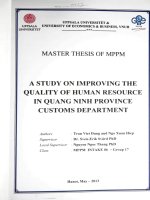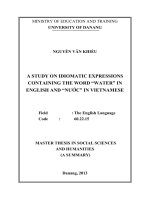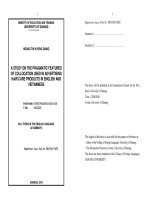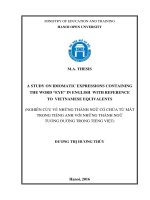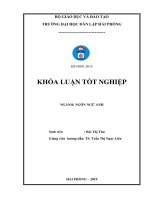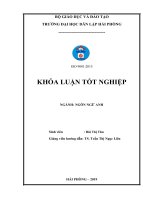A study on vocabulary learning strategies of talented students in english language selection at thanh liem c high school, ha nam province
Bạn đang xem bản rút gọn của tài liệu. Xem và tải ngay bản đầy đủ của tài liệu tại đây (984.7 KB, 57 trang )
VIETNAM NATIONAL UNIVERSITY, HANOI
UNIVERSITY OF LANGUAGES AND INTERNATIONAL STUDIES
FACULTY OF POST-GRADUATE STUDIES
**********************
NHIẾP THỊ VÂN ANH
A STUDY ON VOCABULARY LEARNING STRATEGIES
OF TALENTED STUDENTS IN ENGLISH LANGUAGE
SELECTION AT THANH LIEM C HIGH SCHOOL,
HA NAM PROVINCE
(NGHIÊN CỨU VỀ CHIẾN LƯỢC HỌC TỪ VỰNG CỦA HỌC SINH
ĐỘI TUYỂN HỌC SINH GIỎI MÔN TIẾNG ANH TRƯỜNG THPT C
THANH LIÊM, HÀ NAM)
M.A. MINOR PROGRAMME THESIS
Field: English Teaching Methodology
Code: 60140111
HA NOI - 2016
VIETNAM NATIONAL UNIVERSITY, HANOI
UNIVERSITY OF LANGUAGES AND INTERNATIONAL STUDIES
FACULTY OF POST-GRADUATE STUDIES
NHIẾP THỊ VÂN ANH
A STUDY ON VOCABULARY LEARNING STRATEGIES
OF TALENTED STUDENTS IN ENGLISH LANGUAGE
SELECTION AT THANH LIEM C HIGH SCHOOL,
HA NAM PROVINCE
(NGHIÊN CỨU VỀ CHIẾN LƯỢC HỌC TỪ VỰNG CỦA HỌC SINH
ĐỘI TUYỂN HỌC SINH GIỎI MÔN TIẾNG ANH TRƯỜNG THPT C
THANH LIÊM, HÀ NAM)
M.A. MINOR PROGRAMME THESIS
Field: English Teaching Methodology
Code: 60140111
Supervisor: Dr. Trần Thị Thu Hiền
HA NOI - 2016
DECLARATION
I hereby declare that this dissertation represents my own work and that it
has not been previously submitted to this University or any other institute
in application for admission to a degree, diploma or other qualifications.
Hanoi, 2016
Nhi p Th V n Anh
i
ACKNOWLEDGEMENTS
I would like to express my appreciation, first and foremost, to my
supervisor Dr. Tran Thi Thu Hien, who has patiently and constantly guided
and supported me to develop my study into a practicable frame in the very
beginning and offered valuable suggestions while the work was in progress.
My thanks also go to all the teachers that have instructed me at the National
University for their inspirational lectures in class, by which I have been
motivated to explore some interesting issues concerning English language
teaching and learning .
A special word of thanks goes to my students, without whom it would
never been possible for me to have this thesis accomplished.
Last but not least, I would like to give my immense gratitude to my
family, without whose support my dream of pursuing further study would not
have been possible.
Nhiep Thi Van Anh
ii
ABSTRACT
Although vocabulary forms the biggest part of the meaning of any
language, it is also the biggest problem for most learners.
A study of vocabulary learning strategies was carried out with talented
students in English language selection at Thanh Liem C high school, Ha Nam
province to find the strategies they use most and least popularly. This is only
the initial research (search strategies) to prepare for a long-term study, in
which the useful strategies are applied for other students to improve the
quality of English learning throughout the school.
The research involved
25 talented
students in English language
selection at Thanh Liem C high school, Ha Nam province. Data was collected
from a vocabulary learning strategies questionnaire .
Results of the study showed that the students favoured strategies
focusing on guessing meaning from context, when they encountered new
words. Besides, bilingual and monolingual dictionaries is also a useful tool to
help students find the meaning of words. Moreover, many students are
interested in studying words through English language media such as
television programs, Internet, English songs,…
However, students had difficulty implementing a number of social and
metacognitive strategies, such as interacting with native speakers and testing
oneself with word tests.
To conclude, strategy training
especially on guessing, dictionary
strategies and deep processing strategies is essential. It would be good if
teachers could provide different opportunities
for students to retrieve the
vocabulary learned in different contexts. The results suggested that teachers
should make learners aware of their own responsibility in vocabulary learning
and expose them to different approaches and strategies in enhancing
vocabulary acquisition.
iii
LIST OF ABBREVIATIONS
1
COG
Cognitive strategies
2
DET
Determination Strategies
3
EFL
English as a Foreign Language
4
MEM
Memory Strategies
5
MET
Metacognitive strategies
6
L1
Native Language
7
L2
Second Language
8
SOC
Social Strategies
iv
LIST OF CONTENTS
DECLARATION ............................................................................................ i
ACKNOWLEDGEMENTS............................................................................ ii
ABSTRACT………………………………………………………………….iii
LIST OF ABBREVIATIONS ....................................................................... iv
LIST OF CONTENTS.................................................................................... v
LIST OF TABLES ....................................................................................... vii
CHAPTER ONE : INTRODUCTION ............................................................ 1
1.1 Rationale for choosing the topic ............................................................ 1
1.2 Research question ................................................................................. 3
1.3 Aim and objectives of the study ........................................................... 4
1.4 Scope of the study ................................................................................ 4
1.5. Significance of the study ...................................................................... 4
1.6 Structures of the study ......................................................................... 5
CHAPTER TWO: LITERATURE REVIEW ................................................. 6
2.1. Learning Strategies .............................................................................. 6
2.2 Vocabulary learning strategies............................................................... 8
2.2.1 Definitions of vocabulary learning strategies .................................. 8
2.2.2 Classifications of vocabulary learning strategies ............................ 9
2.3 Previous studies on Vocabulary Learning Strategies .......................... 13
2.4 Summary ............................................................................................ 16
CHAPTER THREE: METHODOLOGY ..................................................... 17
3.1 Research Setting .................................................................................. 17
3.2 Participants .......................................................................................... 17
3.3 Data collection instrument .................................................................. 18
3.4 Method in Language Learning Strategy Research.............................. 20
3.5 Data collection procedure ................................................................... 21
CHAPTER FOUR : FINDINGS AND DISCUSSION ................................. 23
v
4.1 Findings .............................................................................................. 23
4.1.1 Discovery strategies ...................................................................... 23
4.1.2 Consolidation strategies ............................................................... 27
4. 2 Discussion ......................................................................................... 32
CHAPTER FIVE : CONCLUSION.............................................................. 37
5.1 Concluding remarks ............................................................................ 37
5.2 Implications ......................................................................................... 38
5. 3 Limitations ......................................................................................... 39
5.4 Recommendations for further research ............................................... 40
REFERENCES............................................................................................. 41
APPENDIX ..................................................................................................... I
PART 1: The Student‟s Personal Background ................................................ I
PART 2: Vocabulary Learning Strategies Questionnaire .............................. II
vi
LIST OF TABLES
Table 3.1 Information of the participants ..................................................... 18
Table 4.1. Determination Strategies used by the talented students ............... 24
Table 4.2. Social strategies used by the talented students ............................. 25
Table 4.3. Memory strategies used by the talented students ......................... 27
Table 4.4 . Cognitive strategies used by the talented students ...................... 29
Table 4.5. Metacognitive strategies used by the talented students ................ 31
vii
CHAPTER ONE : INTRODUCTION
1.1 Rationale for choosing the topic
Vocabulary is the knowledge of words and word meanings. As Steven
Stahl (2005) puts it, "Vocabulary knowledge is knowledge; the knowledge of
a word not only implies a definition, but also implies how that word fits into
the world." Vocabulary knowledge is not something that can ever be fully
mastered; it is something that expands and deepens over the course of a
lifetime. Instruction in vocabulary involves far more than looking up words in
a dictionary and using the words in a sentence. Vocabulary is acquired
incidentally through indirect exposure to words and intentionally through
explicit instruction in specific words and word-learning strategies.Limited
vocabularies prevent students from comprehending a text. Therefore, an
effective approach to vocabulary is always one of the great concerns of every
language teacher.The reason is that learning vocabulary is really challennging
requiring many cognitive processes, and teachers have to make sure that the
students understand the word and its meaning as well as how to use the word
accurately and appropriately.
At upper- secondary schools in Vietnam, with a short duration of 3
periods per week for all language skills and language focus, vocabulary
instruction has paid less attention than it should have been. Students have to
learn so many new words every week, and by the time they learn the new
words in the new lessons they have forgoten most of the words they have
learned in previous lessons.
Moreover, most of the students, in fact,
are not interested in
vocabulary lessons. They feel bored with the common methods used by
teachers since most of the teachers of English at the researcher‟ school are
still applying the traditional ways of teaching. “Teacher talks – students
1
listen”. These traditional approaches encourage students to recite facts and
figures, not stimulate their thinking and their analytical skills. Consequently,
the students are not able to apply what they‟ve learned, not able to make
connections of what they‟ve just learned and what they had learned in the
past.These traditional methods do not promote active engagement and
participants. As a result, students become passive.They don‟t have
opportunity to participate in learning vocabulary ativities.They consider the
teachers‟explanation for meaning, definition, pronunciation, spelling and
grammatical functions boring.This leads to the problem that language learners
have nothing to do in vocabulary learning section but to listen to their
teacher.
It is known that vocabulary is not available knowlegde, it should be a
long-term cumulative study. The teaching and learning of English vocabulary
becomes more difficult for rural students experiencing problems due to
learning conditions, teachers, etc. Besides, with applying the innovation in the
current exams, many students do not focus on learning English because it is
simply for them to avoid the worst score when doing multiple choice English
tests , therefore, they pass the graduation exam easily .
The researcher is now in charge of teaching English for grade 10 and
12. During teaching,the researcher found that vocabulary plays an important
role in the students‟language learning. It is one element that links the four
skills of speaking, listening, reading and writing all together. In order to
communicate well in a foreign language, students should have a number of
words and should know how to use them accurately.
In fact, the students at Thanh Liem C high school have encountered a
lot of difficulties in remembering as well as using vocabulary.The ability to
apply vocabulary learning strategies is still limited, for example, whenever
2
students think of vocabulary, they think of a list of new words with meaning
in their native language without any real context practice. They look up the
words in bilingual dictionary to find their meaning of new words. Working by
this way, after a short period of time, many students may find out that
learning vocabulary doesn‟t satisfy them. Students often learn to deal with the
checking vocabularies of the teacher, then there are no circumstances and
skills to apply those words, so learning new words becomes useless.
Meanwhile, the talented students in the English language selection proved
that they had capability of learning new words when they achieved good
results in the vocabulary tests.
The writer would like to do a survey to know what English learning
strategies talented students in the English language selection are using
popularly and how often they learn these strategies. From the results of this
initial study, a more long-term study will be conducted in the mass student to
find out, compare and apply for student‟s learning in order to improve
learning English of all students at the writer‟ school. So the writer has decided
to examine the question:“A study on vocabulary learning strategies of talented
students in English language selection at Thanh Liem C high school, Ha Nam
province”
1.2
Research question
The primary aim of the present study is to investigate actual vocabulary
learning strategies that talented students in English language selection at
Thanh Liem C high school have used in English learning, therefore, this
research attempts to answer the following research question:
“What vocabulary learning strategies are most and least popularly used
by the talented students in English language selection at Thanh Liem C high
school ?”
3
1.3 Aim and objectives of the study
The aim of the study is to investigate vocabulary learning strategies
talented students in English language selection at Thanh Liem C high school
have used in English learning. To realize this aim, the paper will :
1. Find the information about vocabulary learning strategies that
talented students in English language selection used when they study words.
2. Draw the most and least popular vocabulary learning strategies
used by talented students in English language selection.
1.4 Scope of the study
The study focuses on exploring vocabulary learning strategies used by
25 talented students who were considered “good learners” at Thanh Liem C
high school. They participated in the exam for talented students annually
with age average between 15-17 years during the first semester of 2015.
Schmitt‟s Taxonomy will be applied to analyse these students‟ use of
vocabulary learning strategies.
1.5. Significance of the study
1.The study can reveal the most and least popularly used vocabulary
learning strategies implemented by the talented students in English language
selection. For talented students in English language selection, exposure to a
large amount of new words and learning vocabulary through vocabulary
learning strategies can develop good habits in terms of English learning as
they study English at high school. Thus, if the instruction of vocabulary
learning strategies leads to good results, it can be put to use in wider scale and
teachers could have a better idea about how to help students learn vocabulary
effectively.
2.The teachers can implement the findings of this study to support high
proficient students and encourage weaker students to get better results.
4
Moreover, this study gives recommendations to other teachers of English on
how to teach the students to use vocabulary stratergies effectively to improve
their learning vocabulary in classes.
3. From the results of this study, talented students in English language
selection also need to adjust the vocabulary strategies to achieve higher
academic results. Besides, the writer will continue to conduct other research
to a wider audience, the mass of students to have overview that helps regulate
the teaching and learning of teachers and students in the researcher‟s school .
1.6 Structures of the study
The study is organized as follow:
Chapter 1: Introduction – provides an overview of the study
Chapter 2 : Liturature Review - a view of relevant liturature on this
issue is presented.
Chapter 3: Research Methodology- a description of research methods is
discussed in detail, including a description of selection of the participants,
data collection instruments and data collection procedures.
Chapter 4: Finding and discussions - the results of the study are
presented.
Chapter 5: Conclusion - the researcher provides a summary on main
points raised in the study, the major conclusion drawn from conducting this
study, and a discussion of the study‟s limitations and suggestions for further
research.
5
CHAPTER TWO: LITERATURE REVIEW
This chapter examines the literature and research relevant to language
learning strategies and vocabulary learning strategies.
2.1. Learning Strategies
The term “strategy” is of military origin where it refers to carefully
designed plans for military operations (Oxford, 1990:7). There have been
numerous attempts to define strategies. According to Rubin (1975:43),
strategies are “ the techniques or devices which a learner may use to acquire
knowledge.” When applied to a
non military
setting
like
school
learning, the strategy concept has been taken on a new meaning and has
been transformed into learning strategies. Learning strategies have been
defined in various ways in literature and they are connected to several areas
of language learning.
Learning strategies are thoughts or behaviour the
learners use to comprehend, learn or retain new information. (O‟Malley and
Chamot 1990:1)
When O'Malley et al. (1985) came to conduct their research, they based
their definition on Rigney‟s (1978) definition of learning strategies as
procedures which facilitate acquisition, retention, retrieval, and performance.
Whereas, Oxford (1990:8) provided
another well-known
definition of
language learning strategies as “specific actions taken by the learner to make
learning easier, faster, more enjoyable, more self-directed, more effective, and
more transferable to new situations.”
In addition, Takala (1996, as cited in Kristiansen 1998:44) determines
the word “strategy”: “Strategies are taken to be the behaviours that the
learners engage in during learning that are intended to influence cognitive
andaffective processing.” Meanwhile, Ellis (1985:165) points out that native
6
language speakers
use
the same
strategy types as learners of second
language. However, there are differences in the frequency of strategy use
between native speakers and non-native speakers.
The term language learning strategies has many different definitions.
Research into language learning strategies began in the 1960s and the term
language learning strategy has been defined by many researchers. In most of
the research on language learning strategies, the primary concern has been on
"identifying what good language learners report they do to learn a second or
foreign language, or, are observed doing while learning a second or foreign
language." (Rubin and Wenden 1987:19). Wenden and Rubin (1987:19)
define learning strategies as "... any sets of operations, steps, plans, routines
used by the learner to facilitate the obtaining, storage, retrieval, and use of
information."According to Stern (1992:261),"the concept of learning strategy
is dependent on the assumption that learners consciously engage in activities
to achieve certain goals and learning strategies can be regarded as broadly
conceived intentional directions and learning techniques."All language
learners use language learning strategies either consciously or unconsciously
when processing new information and performing tasks in the language
classroom. Since language classroom is like a problem-solving environment
in which language learners are likely to face new input and difficult tasks
given by their instructors, learners' attempts to find the quickest or easiest way
to do what is required, that is, using language learning strategies is
inescapable. Griffiths (2008) explained that language learning strategies are
activities consciously chosen by learners for the purpose of regulating their
own learning. Griffiths also demonstrated and showed a correlation between
language learning strategy use and English proficiency.
7
2.2 Vocabulary learning strategies
2.2.1 Definitions of vocabulary learning strategies
The term “vocabulary learning strategies” refers to “any set of
techniques or learning behaviours, which language learners reported using in
order to discover the meaning of a new word, to retain the
knowledge
of newly-learned words, and to expand one‟s knowledge of vocabulary”
(Intaraprasert 2004:53). Learner autonomy can be enhanced by introducing
learner to different vocabulary learning strategies which can be used in
developing the learning process.
O‟Malley and Chamot (1990:7) supposed that training second language
learners to use learning strategies concentrates mainly on learning vocabulary.
They also point out that vocabulary learning strategies are used most
frequently and are probably the most well-known type of language learning
strategies; but other author mentions that, in comparison with other aspects of
language, such as grammar and pronunciation, vocabulary is the area of
language that learners seem most conscious of.
Vocabulary learning strategies are a subcategory of language learning
strategies which in turn are a subcategory of learning strategies in general. If
language learning strategies can be defined as “specific actions taken by the
learner to make learning easier, faster, more enjoyable, more selfdirected,
more effective, and more transferable to new situations.” (Oxford, 1990:8),
and vocabulary learning strategies constitute knowledge about what students
do to find out the meaning of new words, retain them in long-term memory,
recall them when needed in comprehension, and use them in language
production (Catalan 2003, in: Ruutmets, 2005).
According to Schmitt (1997:199), summarising previous research, that
many learners use vocabulary learning strategies and many learners agree that
vocabulary is an essential part of language. Schmitt (1997:200) notes that
8
even though many studies have been made about language learning strategies
and vocabulary learning, only a few of them have discussed vocabulary
learning strategies. Schmitt (1997:200–201) states that the research done on
the field of vocabulary learning strategies typically concentrates only on
individual or small number of strategies. He believed that the research has
shown patterns of strategy use which can be changed over time when the
learner gets older or becomes more proficient in the language he or she is
studying. Therefore some strategies are more popular in certain age groups (
Schmitt 1997:223).
2.2.2 Classifications of vocabulary learning strategies
In classifying learning strategies, researchers have different ways of
classifying
classification
vocabulary
language learning strategies (Intaraprasert 2004:10). These
systems
give
crucial contribution to the knowledge of
strategies. Below is a summary, brief discussion as well as
consideration of
the classification
systems
of vocabulary
learning
strategies which have been identified in different contexts by different
scholars, such as Cohen (1987;1990); Gu and Johnson‟s (1996) and Schmitt‟s
(1997).The writer selected the classification of these scholars because it is
an useful reference source for the researcher to conduct her own research.
2.2.2.1 Cohen’s classification of vocabulary learning strategies
Vocabulary Learning strategies classified by Cohen (1987:43;1990:2137) were put together and could be devided into three main categories :
Category 1: Strategies to remember words
It means that learners use rote-repetition by repeating the word and its
meaning until it seems to have stuck; Besides, using mnemonic associations is
necessary through :
9
- linking the word to the sound of a word in the native language
to the sound of a word in another language, or linking the word to the
situation in which it appeared.
- attending to the meaning of a part of the word or noting the
structure of part and visualising the word in isolation or in a written context .
- placing the word in the topic group and creating a mental image of
the word .
- associating some physical sensation to the word or associating the
word to a keyword; and
using of mnemonic device in order to create a
cognitive link between an unfamiliar foreign language word .
Category 2: Semantic Strategies involves in
- Thinking of synonyms in order to build a network of interlinking
concepts
- Clustering words by topic group or type of word ; and linking the
word to another sentence.
Category 3: Vocabulary Learning and Practising Strategies
Analyse the word according to its roots, affixes, and inflections as
a way to understand its meaning. Words in two languages such as using a
Dictionary, the Use of Flash Cards, Grouping and Cumulative Vocabulary
Study.
Besides, vocabulary learning strategied proposed by Cohen (1987;
1990) have been found to share some common characteristics, therefore,
they could be put together to create the new three main categories. They
consist of
strategies like
remembering words, semantic strategies, and
vocabulary learning and practising strategies.
2.2.2.2 Gu and Johnson’s classification of vocabulary learning
strategies
10
Gu and Johnson (1996:51) investigate Chinese advanced learners‟ use
of English vocabulary learning strategies by using the questionnaire. Gu
and Johnson (1996) note
L2 vocabulary
learning
strategies as
metacognitive, cognitive, memory and activation strategies. These scholars
developed a
substantial list
of English foreign language
vocabulary
learning strategies reported employing by advanced Chinese learners. The
study has profiled the beliefs and strategies of
adult Chinese learners for
learning EFL vocabulary. A wide variety of English vocabulary learning
strategies are developed and grouped into following categories:
Metacognitive strategies consist of selective awareness and self-initiation
strategies. L2 learners employing selective awareness strategies know which
words are important for them to learn and are
comprehension of a
essential
for
adequate
passage. Learners employing self- initiation strategies
use a variety of means to make the meaning of vocabulary items clear.
Cognitive strategies in Gu and Johnson‟s classification involve
guessing strategies, skillful use of dictionaries and note-taking strategies.
When using guessing strategies, learners draw upon their background
knowledge and use linguistic
clues like grammatical structures of a
sentence to guess the meaning of new word.
Memory strategies are classified into practicing and encoding
categories. Word lists and repetition are instances of practicing strategies.
Instructing strategies include strategies such as association, imagery,
visual, auditory, semantic, and contextual encoding as well as word-structure
( analyzing a word in terms of prefixes and suffixes).
The activation strategies
refer to
strategies
that
the learners
actually use new words in different contexts. For example, learners may set
sentences using the words they have learned.
11
2.2.2.3 Schmitt’s classification of vocabulary learning strategies
Schmitt‟s (1997) taxonomy of vocabulary learning strategies is
organized
in
two
groups:
Discovery Strategies
and
Consolidation
Strategies.
The following is the strategy inventory offered by Schmitt
(1997).These vocabulary learning strategies were devided into two main
categories:
Category 1: Discovery Strategies.
This category consists of Determination Strategies (DET) and Social
Strategies (SOC).
In Determination Strategies, Schmitt‟s (1997) supposed that learners
paid attention to strategies such as analysing part of speech, analysing
affixes and roots, checking for L1 cognate, analysing any available pictures
or gestures, guessing meaning from textual context, and using a dictionary
(bilingual or monolingual).
In Social Strategies , Schmitt‟s (1997) thought that learners used
strategies ,for instance, asking teacher for a synonym, paraphrase, or L1
translation of new word and asking classmate for meaning when they
discover the meaning of new words.
Category 2: Consolidation Strategies .
Consolidation Strategies includes strategies for consolidating a word
once it has been encountered. Schmitt‟s (1997) stressed on four types of
strategies like :
Social Strategies (SOC) use interaction with other people to improve
language learning. Learners may study and practise meaning in a group
or interact with native speaker, or by any combination of these.
12
In Memory Strategies ( MEM ), Schmitt (1997) explains that most
memory strategies involve
relating the word to
be retained with prior
knowledge. For example, studying new words with
meaning, associating
the word with
pictures of
their
its coordination, synonymy, or
antonymy, using a scale for gradable adjectives or even grouping words
together within a story line.
Besides,Cognitive strategies (COG) do not engage learners in mental
processing but is more mechanical. In Cognitive strategies, Schmitt (1997)
refers to Verbal and Written repetition, Word lists, Putting English labels on
physical objects and Keeping a vocabulary notebook.
Metacognitive strategies (MET) are strategies relating to
processes
involving monitoring, decision-making, and evaluation of learners‟progress.
Metacognitive
strategies
help
the
learner in determining appropriate
vocabulary learning strategies for learning new words. It includes
using
English-language media (songs, movies, newscasts, etc.), Testing oneself
with word tests, Skiping or passing new word and Continuing to study word
over time.
2.3 Previous studies on Vocabulary Learning Strategies
Research on general learning strategies showed that many of them are
used for vocabulary learning. O‟Malley and Chamot (1990:7) note that
research on the effect of training L2 learners to use learning strategies is
often restricted to application of vocabulary tasks . Learners are found to use
more learning strategies for vocabulary acquisition than for other language
activities (Takač, 2008). In one of the first large-scale studies, Ahmed (1989)
investigated how good and poor learners (300 EFL learners in Sudan) applied
vocabulary-learning strategies. For the data collection Ahemd used a thinkaloud procedure, observations, questionnaires, and interviews. The results
13
showed that both good and poor learners used the same macro- strategies
(note-taking, memorization, practice, dictionaries or other information
sources), but good learners applied more micro-strategies within each macrostrategy; for example, they often used words in context or tested themselves
while practicing.
Gu and Johnson (1996) designed a questionnaire based on previous
strategy research (Oxford, 1990). The questionnaire provided one of the most
comprehensive lists of vocabulary strategies: 108 items. It included three
sections: vocabulary learning beliefs, metacognitive strategies, and cognitive
strategies. Gu and Johnson (1996) administered the questionnaire to 850
Beijing University sophomores who had about six years of English learning
experience. The researchers were interested in the ways learners combined
different strategies, and if the choice of strategy combinations correlated with
students‟vocabulary size and general language proficiency. Learners were
classified by their strategy profiles and learning outcomes into five
groups.The findings revealed that the group of students with the highest
English test scores believed that vocabulary should be picked up through
natural exposure (reading, guessing, contextual encoding) and careful study,
but not memorization. They actively looked for opportunities to use English
outside the classroom. The second best group of participants also believed in
natural acquisition, careful study, and use of new words, but in addition they
had positive feelings about the memorization of words. They used almost
every strategy and spent a lot of time and effort on learning English. Gu and
Johnson (1996) believed that they might have succeeded due to their efforts,
but not to particular strategy use. Most of students in the study reported
average use of various strategies, and the group with lowest English test
14
scores strongly believed in the effectiveness of only a very restricted set of
strategies: memorization and visual repetition.
Vocabulary size correlated positively with general English proficiency.
Positive correlations were also found between both variables
and such
strategies as contextual guessing, seeking personally significant vocabulary,
using vocabulary that was not studied in class, active use of dictionaries for
learning purposes (not for comprehension only), meaning-oriented notetaking, paying attention to word formation, and creating semantic associations
and networks. Strategies aimed at vocabulary retention correlated more with
vocabulary size than with language proficiency. Oral repetition and English
proficiency correlated positively, but visual repetition of new words
correlated negatively with both vocabulary size and English proficiency.
Memorization of vocabulary was found to be useful only when it was used in
cluster with many other strategies.
Schmitt‟s (1997) 58-item questionnaire was administered to 600
Japanese EFL learners of different ages: junior-high school, high school,
university students, and adult learners. Schmitt(1997) distinguished between
strategies used for discovery of new words and strategies for consolidating the
knowledge. Discovery strategies included determination strategies used for
independent looking up of the word‟s meaning and social strategies used for
asking teachers or classmates for a meaning. Consolidation strategies included
social, cognitive, metacognitive, and memory strategies. The participants
were asked to indicate what strategies they used most often, and what
strategies they found most helpful.
The results showed that most frequently used strategies included using
a bilingual dictionary, verbal and written repetition, studying the spelling,
guessing from context, and saying the word aloud. The strategies reported as
15
most helpful coincided with the most used ones: bilingual dictionary use,
saying the new word aloud, oral repetition, and written repetition. The results
also showed changes in strategy use as learners matured: The youngest
learners favored repetition, focus on form, L1–L2 word lists and cards. More
mature learners reported more strategies that involved deeper processing:
imaging, associations, and analysis.
Many more studies have investigated individual vocabulary-learning
strategies, but only a few strategies have been researched in depth. The most
extensively studied vocabulary learning strategies are memory-based and
inferencing strategies (Schmitt, 1997).
2.4 Summary
Chapter two has mainly examined some significant aspects of
vocabulary learning, vocabulary learning strategies and available research
works on vocabulary learning
strategies. Through the broad literature
review in the field of vocabulary learning strategies, it can be seen that
several
researchers
have
made use
of
different vocabulary learning
strategy classification systems. Previous research work has been carried out in
a variety of purposes of the investigation, target populations, methods of data
collection, places of research conduction, and
factors.
16
different
variables
or

